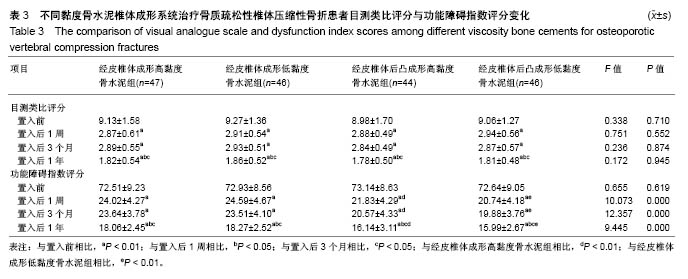| [1] 麦合木提江•穆海麦提,祝少博,李景峰,等.两种方法治疗骨质疏松致椎体压缩性骨折:安全与有效性的Meta分析[J].中国组织工程研究,2014,18(22):3551-3559.[2] 陈志强,石磊.椎体后凸成形术治疗老年骨质疏松脊柱压缩骨折[J].吉林医学,2018,39(3):500-502.[3] 冯新民,王静成,张亮,等.高黏度骨水泥在修复骨质疏松性胸腰椎骨折中的应用[J].中国组织工程研究,2014,18(30):4757-4763.[4] 张亮,王静成,冯新民,等.高粘度骨水泥椎体成形术与普通粘度椎体后凸成形术治疗骨质疏松性椎体压缩性骨折的效果比较[J].中国老年学杂志,2017,37(18):4601-4603.[5] 印平,马远征,马迅,等.骨质疏松性椎体压缩性骨折的治疗指南[J].中国骨质疏松杂志,2015,21(6):643-648.[6] 孙阳.经皮穿刺椎体成形术与保守法治疗骨质疏松性椎体压缩性骨折短期疗效对比[J].中国老年学杂志,2014,34(17): 5005-5006.[7] 周英杰,赵鹏飞,郑怀亮,等.两种骨水泥应用于老年胸腰椎骨折椎体成形术的疗效观察[J].中国矫形外科杂志,2015,23(4): 364-367.[8] 孟胜伟,蒋盛旦,蒋雷生.胸腰椎骨质疏松性椎体压缩性骨折椎体强化术后腰背痛原因的研究进展[J].脊柱外科杂志, 2017,15(2): 117-122.[9] 汪群,隋福革,汪丽静,等.经皮椎弓根钉棒置入结合椎体成形治疗胸腰椎压缩性骨折[J].中国组织工程研究,2014,18(17): 2716-2721.[10] 刘华,刘璠,魏爱淳,等.微创治疗老年骨质疏松性椎体压缩性骨折[J].中国现代医学杂志,2013,23(6):76-80.[11] 吕良庆,韦向东,蒙世远,等.老年骨质疏松性椎体压缩性骨折的治疗进展[J].中国临床新医学,2013,6(11):1123-1128.[12] 李志君,慈元,郑玉鹏,等.经皮椎体后凸成形注入骨水泥治疗骨质疏松性胸腰椎压缩骨折[J].中国组织工程研究, 2012,16(43): 8000-8004.[13] Zhai W, Jia Y, Wang J, et al. The clinical effect of percutaneous kyphoplasty for the treatment of multiple osteoporotic vertebral compression fractures and the prevention of new vertebral fractures. Int J Clin Exp Med. 2015;8(8):13473-13481. [14] Zhang L, Liu Z, Wang J, et al. Unipedicular versus bipedicular percutaneous vertebroplasty for osteoporotic vertebral compression fractures: a prospective randomized study. BMC Musculoskelet Disord. 2015;16:145. [15] Ee GW, Lei J, Guo CM, et al. Comparison of Clinical Outcomes and Radiographic Measurements in 4 Different Treatment Modalities for Osteoporotic Compression Fractures: Retrospective Analysis. J Spinal Disord Tech. 2015;28(6): E328-335.[16] 穆小平,易伟林,韦建勋,等.高黏度与普通黏度骨水泥椎体成形系统修复骨质疏松性椎体压缩性骨折的荟萃分析[J].中国组织工程研究,2017,21(2):322-328.[17] 彭昊,谭俊峰,刘洋,等.高黏度骨水泥与传统骨水泥治疗骨质疏松性椎体压缩性骨折的疗效比较[J].生物医学工程与临床, 2014, 18(4):344-348.[18] 杨刘柱,陈仲,严鑫平,等.椎体骨水泥注入联合抗骨质疏松药物治疗急性骨质疏松性椎体压缩性骨折[J].中国组织工程研究, 2014, 18(39):6265-6270.[19] 赵江,赵宇,李德成,等.经皮骨水泥注入对老年骨质疏松性椎体压缩性骨折患者的治疗效果[J].现代生物医学进展, 2016,16(30): 5864-5867.[20] 陈学忠,董玮,奚江明,等.高黏度与低黏度骨水泥在椎体成形术中应用的临床对比研究[J].成都医学院学报,2015,10(2):186-189.[21] 李停,宋建东,李志钢,等.经皮球囊扩张椎体后凸成形术治疗骨质疏松性椎体压缩性骨折骨水泥渗漏的预防[J].武汉大学学报(医学版),2014,35(2):314-317.[22] 铁镔,何仕诚,滕皋军,等.经皮椎体成形术后骨水泥渗漏的CT评价[J].中华医学杂志,2012,92(5):299-302.[23] 周湘桂,李思云.骨质疏松性椎体压缩性骨折治疗研究进展[J].中国骨质疏松杂志,2012,18(11):1062-1065.[24] Park JH, Kang KC, Shin DE, et al. Preventive effects of conservative treatment with short-term teriparatide on the progression of vertebral body collapse after osteoporotic vertebral compression fracture. Osteoporos Int. 2014;25(2): 613-618. [25] 洪鑫,吴小涛,刘磊,等.经皮椎体成形术和经皮椎体后凸成形术治疗重度骨质疏松性椎体压缩性骨折疗效分析[J].中国骨质疏松杂志,2011,17(11):969-973.[26] Zhao DH, Chen K, Zhu J, et al. Postoperative Functional Evaluation of Percutaneous Vertebroplasty Compared With Percutaneous Kyphoplasty for Vertebral Compression Fractures. Am J Ther. 2016;23(6):e1381-e1390.[27] 许立超,肖湘生.经皮椎体后凸成形术目前存在的若干问题[J].介入放射学杂志,2008,17(2):145-147.[28] 黄晓楠.骨质疏松性椎体压缩骨折治疗:注入高黏度与低黏度骨水泥的对比[J].中国组织工程研究,2014,18(16):2461-2467.[29] Hulme PA, Krebs J, Ferguson SJ, et al. Vertebroplasty and kyphoplasty: a systematic review of 69 clinical studies. Spine (Phila Pa 1976). 2006;31(17):1983-2001.[30] Eck JC, Nachtigall D, Humphreys SC,et al. Comparison of vertebroplasty and balloon kyphoplasty for treatment of vertebral compression fractures: a meta-analysis of the literature. Spine J. 2008;8(3):488-497. [31] Wang CH, Ma JZ, Zhang CC, et al. Comparison of high-viscosity cement vertebroplasty and balloon kyphoplasty for the treatment of osteoporotic vertebral compression fractures. Pain Physician. 2015;18(2):E187-194.[32] Niu J, Zhou H, Meng Q, et al. Factors affecting recompression of augmented vertebrae after successful percutaneous balloon kyphoplasty: a retrospective analysis. Acta Radiol. 2015;56(11):1380-1387. [33] 李晶.椎体后凸成形术治疗骨质疏松性椎体压缩性骨折的临床疗效观察[J].四川解剖学杂志,2017,25(1):23-25.[34] Chen X, Ren J, Zhang J, et al. Impact of Cement Placement and Leakage in Osteoporotic Vertebral Compression Fractures Followed by Percutaneous Vertebroplasty. Clin Spine Surg. 2016;29(7):E365-370. [35] Wang YT, Wu XT, Chen H, et al. Adjacent-level symptomatic fracture after percutaneous vertebral augmentation of osteoporotic vertebral compression fracture: a retrospective analysis. J Orthop Sci. 2014;19(6):868-876. [36] 黄天霁,寇玉辉,殷晓峰,等.椎体强化术后再发椎体骨折的临床特点和危险因素[J].北京大学学报(医学版),2015,47(2):237-241.[37] Rebolledo BJ, Gladnick BP, Unnanuntana A, et al. Comparison of unipedicular and bipedicular balloon kyphoplasty for the treatment of osteoporotic vertebral compression fractures: a prospective randomised study. Bone Joint J. 2013;95-B(3):401-406. [38] 杜曼•吐鲁木汗,祖帕尔•苏来曼,塔扎别克.后凸成形与椎体成形治疗骨质疏松性椎体压缩骨折的Meta分析[J].中国组织工程研究, 2014,18(13):2089-2095.[39] 王峙锦,王宏,马凯,等.高粘度骨水泥PVP 或PKP 结合体位复位治疗胸腰椎骨质疏松性椎体压缩骨折的疗效观察[J].中国骨关节损伤杂志,2016,31(S1):1-2.[40] 笪晓伟,李启中,区杰雄,等.高黏度与低黏度骨水泥在经皮椎体后凸成形术中的应用比较[J].中国骨科临床与基础研究杂志, 2015, 7(2):79-83.[41] Rapan S, Jovanovi? S, Gulan G, et al. Vertebroplasty--high viscosity cement versus low viscosity cement. Coll Antropol. 2010;34(3):1063-1067.[42] Lador R, Liberman S, Ben-Galim P, et al. A cadaver study to compare vertebral augmentation with a high-viscosity cement to augmentation with conventional lower-viscosity cement. J Spinal Disord Tech. 2013;26(2):68-73. |
.jpg)




.jpg)
.jpg)